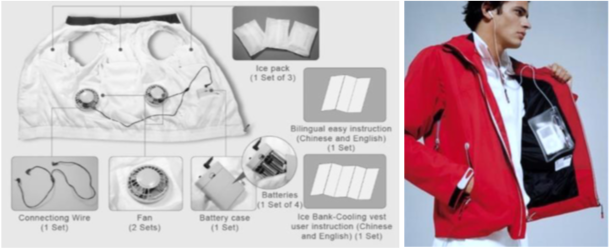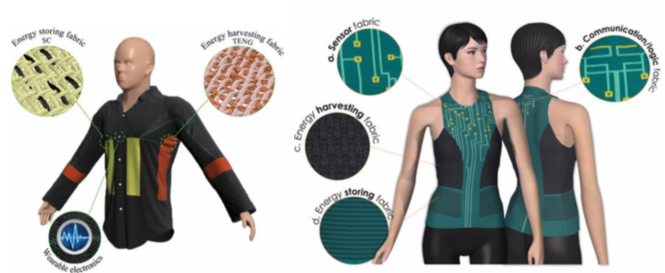Thanks to the research on fiber or textile composites with functions of sensing, actuating, communicating and computing, there are increasing attempts to create e-textiles with add-on or built-in electronic functionalities. The possibility for electronic textile systems includes but not limited to flexible circuits, interfacing computers, sensors, radio-frequency identification tags, energy storage and other devices, which are potential applications for personal fitness, public safety, biomedical and health care, and military.
The applications of e-textiles or smart textiles are categorized into attachment, connection, and integration levels1.
In the attachment level, non-textile functional devices are attached to the garments, for example, the cooling vest2 to protect workers from heat strokes, and the jacket for music playing.
The products in the connection level interconnect the functional elements and the textile components. The following figures show glowing clothes with sewable circuitry and the Levi’s Commuter Tracker Jacket3 that realizes smartphone control by swiping or tapping the fabric on the cuff.
In the integration level, specific functions are integrated into the textile structure. For example, the self-charging power textile scheme, illustrated on the left of the figure, integrates the supercapacitor (SC) yarns as energy-storing fabrics, the triboelectric nanogenerator (TENG) cloth as energy-harvesting fabrics, and wearable electronics like button sensors4. The figure on the right demonstrates a research outcome for fabric-like materials for storing power with graphene and carbon nanotubes5.
- DIAS, T., 2015. Electronic textiles: smart fabrics and wearable technology. Woodhead Publishing series in textiles .Cambridge: Woodhead Publishing.
- https://www.polyu.edu.hk/ife/corp/en/publications/tech_front.php?tfid=7774 [14-09-2018]
- https://www.theverge.com/2017/9/25/16354712/google-project-jacquard-levis-commuter-trucker-jacket-price-release-date [14-09-2018]
- PU X. et al., 2016. Wearable Self‐Charging Power Textile Based on Flexible Yarn Supercapacitors and Fabric Nanogenerators. Advanced Materials, V28, I1.
- https://www.extremetech.com/extreme/207438-knitted-supercapacitors-could-store-power-in-your-pants [14-09-2018]


